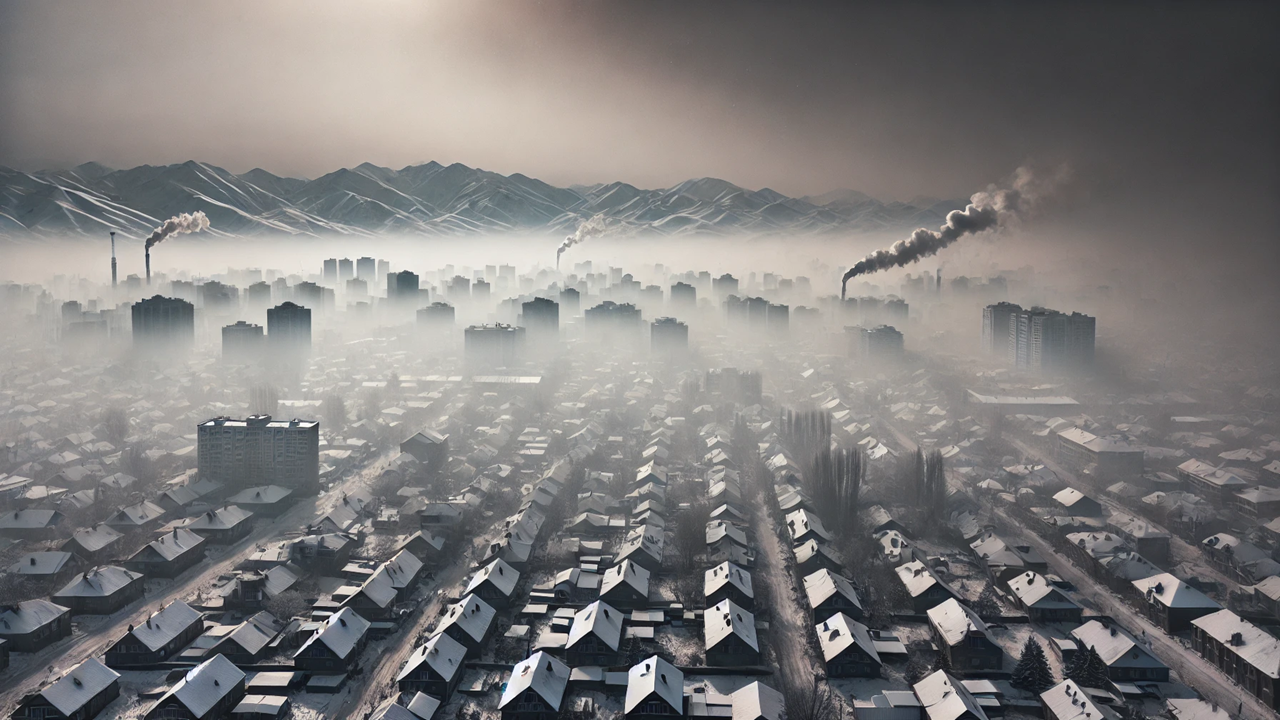Bishkek’s Battle Against Air Pollution: Urgent Measures Needed to Combat Dangerous PM2.5 Levels
Bishkek, Kyrgyzstan, faces a severe air quality crisis, with PM2.5 levels exceeding WHO guidelines by more than tenfold. A recent World Bank report outlines the primary sources of pollution—residential heating, road traffic, and seasonal windblown dust—and offers targeted strategies to reduce emissions. Key recommendations include transitioning to cleaner heating alternatives, modernizing the vehicle fleet, and implementing effective urban planning. A comprehensive, multi-sectoral approach is essential to combat this growing threat to public health and the economy.

Understanding Bishkek’s Air Quality Crisis
Bishkek, the capital of Kyrgyzstan, faces a severe air pollution problem, as highlighted in a recent report titled “Air Quality Analysis for Bishkek: PM2.5 Source Apportionment and Emission Reduction Measures” published by the World Bank in September 2023. According to the report, the city’s annual PM2.5 levels exceed the World Health Organization (WHO) guidelines by over tenfold. This alarming situation places Bishkek among the world’s most polluted cities and has far-reaching implications for public health and economic well-being.
The report reveals that the primary sources of PM2.5 (particulate matter less than 2.5 micrometers in diameter) include residential heating, road transport, and windblown dust. Each of these factors contributes significantly to the toxic air that millions of residents breathe daily. As the seasons change, the sources of pollution shift, making effective management a complex, multi-layered challenge.
The Heavy Toll of Winter Heating
In Bishkek, residential heating is a significant contributor to PM2.5 emissions, particularly during the cold winter months. Nearly 40% of the city’s pollution in winter is attributed to coal-burning stoves and inefficient heating systems in single-family homes. The reliance on coal, combined with low temperatures that trap pollutants near the ground, leads to a hazardous buildup of particulate matter, making winter the most dangerous time for air quality.
The World Bank’s analysis points out that households in northern Bishkek, where coal is most commonly used for heating, experience the highest levels of pollution. This is not just a matter of environmental concern but a pressing public health issue. Long-term exposure to PM2.5 is linked to severe respiratory and cardiovascular diseases, and in some cases, it can even lead to premature death.
Summer Dust and Year-Round Traffic
While residential heating dominates during winter, summer brings its own set of challenges. Windblown dust from surrounding areas and urban dust from construction and road activities become the leading sources of pollution. This natural phenomenon worsens when dry spells hit the region, pushing PM2.5 levels well beyond the acceptable limits. Unfortunately, the situation is exacerbated by road traffic, which remains a constant source of pollution throughout the year.
The report identifies that almost all vehicles in Bishkek are older models with limited emission controls. Heavy-duty trucks and older cars spew particulate matter and other pollutants into the air, contributing to an annual PM2.5 concentration that far exceeds safety guidelines. Even during the less polluted summer months, PM2.5 levels remain more than double the WHO recommendations.
The Path Forward: Emission Reduction Strategies
Given the multifaceted nature of Bishkek’s air pollution problem, the World Bank report emphasizes that no single solution will suffice. Instead, a combination of sector-specific measures is needed to bring air quality to acceptable levels. Key recommendations include:
Modernizing Residential Heating: The most effective intervention would be a complete switch from coal to cleaner heating technologies, such as heat pumps and electric boilers. According to the report, such a measure could reduce PM2.5 emissions by up to 29% in the affected areas.
Improving Transport Emissions: The city should implement stricter emissions standards and promote the use of cleaner vehicles. Introducing zero-emission electric buses and modernizing the vehicle fleet could reduce transport-related PM2.5 emissions by 13% annually.
Enhanced Urban Planning and Greening Efforts: Planting vegetation to reduce urban dust and better-managing construction activities can help control seasonal dust. Although these measures alone will not solve the problem, they provide multiple co-benefits, including improved urban aesthetics and public health.
Strengthening Air Quality Management Systems: The report calls for the creation of an inter-ministerial committee to oversee air quality issues and a comprehensive air quality master plan for Bishkek. Effective management would require coordinated efforts from various stakeholders, including government bodies, civil society, and international partners.
Urgency and Opportunity for Change
The report underscores that effective emission reduction will require substantial investments and policy changes. However, the stakes are high. Bishkek’s annual health damages from air pollution amount to 1.2% of the national GDP, indicating that the cost of inaction is far greater than the investment needed to clean up the air.
Implementing the proposed measures would not only improve air quality but also result in significant co-benefits, such as reduced greenhouse gas emissions, better public health outcomes, and enhanced quality of life for Bishkek’s residents. For a city grappling with economic and environmental challenges, this is an opportunity to turn the tide on air pollution and set an example for other urban centers facing similar issues.
The Way Forward
The findings of the Air Quality Analysis for Bishkek provide a robust foundation for crafting a sustainable air quality strategy. This document should serve as a starting point for dialogue and action, guiding policymakers, citizens, and international partners as they work together to develop a cleaner, healthier future for Bishkek.
The recommendations emphasize a holistic, multi-sectoral approach to tackle air pollution. With decisive action, Bishkek can reclaim its air, reduce the health burden on its citizens, and pave the way for sustainable urban development.
- FIRST PUBLISHED IN:
- Devdiscourse
ALSO READ
Solomon Islands Urged to Pursue Comprehensive Reforms to Boost Economic Growth, Says World Bank Report
Mongolia Faces Challenges in Sustaining Gender Equality Despite Reforms: World Bank Report
World Bank Report: Productivity Growth and Social Inclusion Key to Poland’s Future Competitiveness
World Bank Report Highlights Somalia's Economic Gains, but Poverty Remains Stubborn Challenge
Zambia Must Boost Revenue and Improve Fiscal Governance to Spur Economic Growth: World Bank Report










